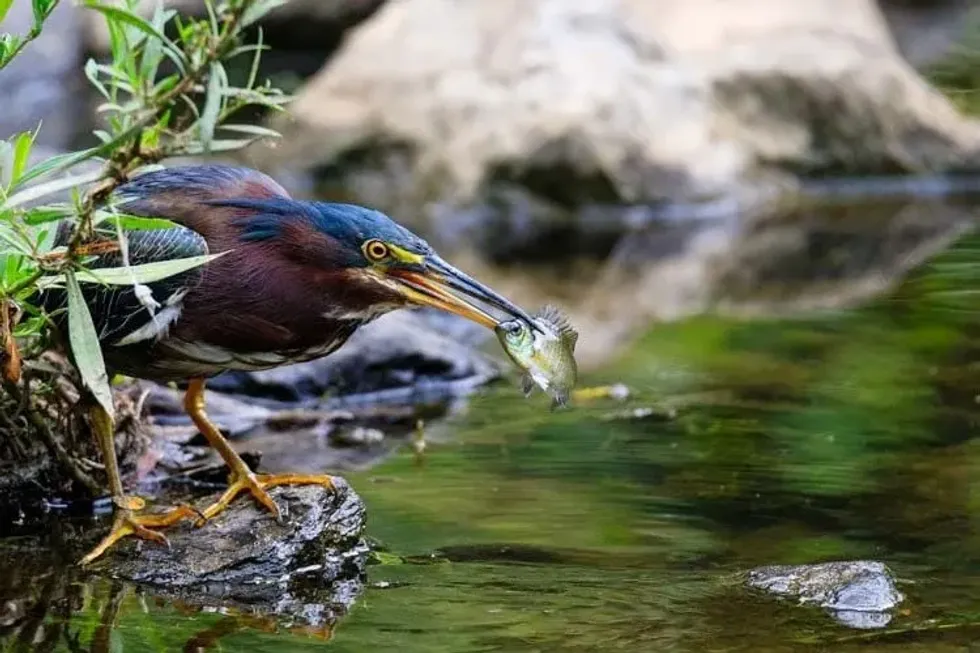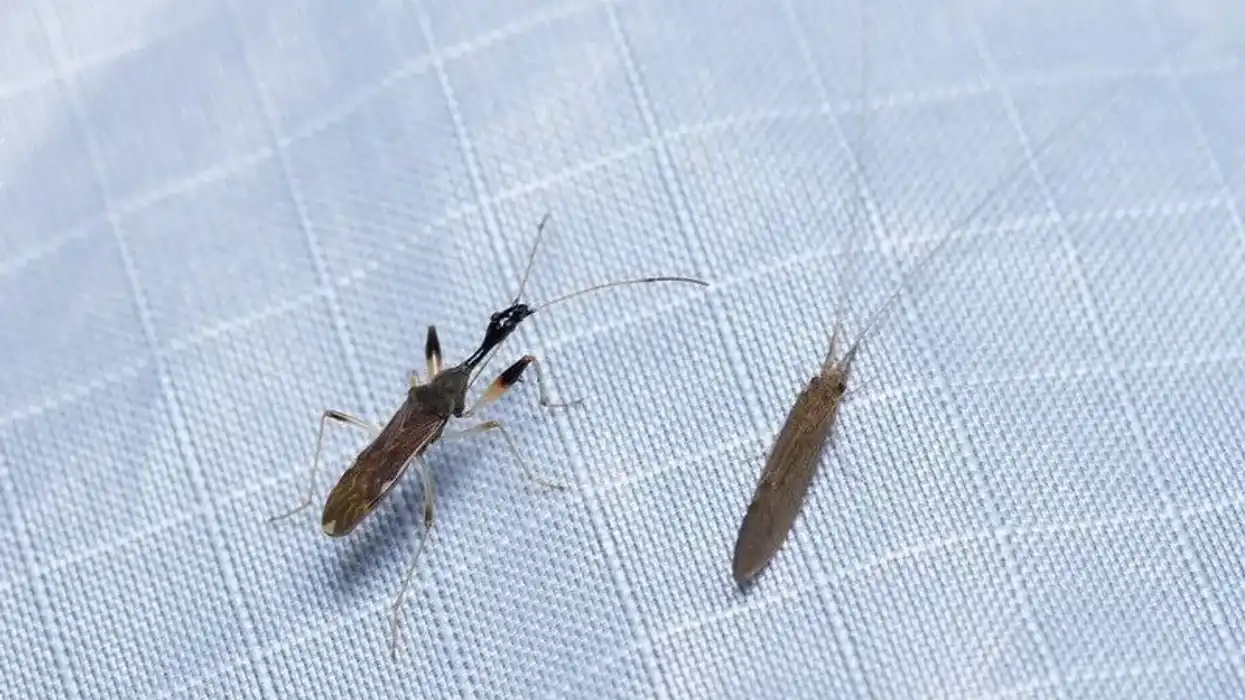The pumpkinseed fish is a freshwater or pond perch fish that is popularly seen in freshwater regions of North America, often in shallow bodies of water like pools of creeks. Their scientific name is Lepomis gibbosus.
This species of fish is agile during the day and rests during the night. They feed on food sources available at all levels of the water body and reside where aquatic vegetation can keep themselves safe and secure.
The heaviest feeding happens during the daytime.
Tiny pumpkinseeds in their first year grow about 2 in (5 cm) and live on average for 6-8 years. Female and male pumpkinseeds differ in the color and texture of their skin; male pumpkinseeds have bright red, yellow, and other colors while females are darker color.
They are often mistaken for bluegills but are duller in appearance with their dorsal fin.
Although the pumpkinseed fish and bluegill fish are different varieties of the same family, they differ in appearance and pumpkinseeds are more tolerant to low levels of oxygen compared to the bluegill species.
In this article, we will take a look at some fun and interesting facts about these unique beings, so read on to discover all there is to know about the pumpkinseed Lepomis gibbosus.
If you like these facts, take a look at fluke fish and drum fish articles as well.
Pumpkinseed Sunfish Interesting Facts
What type of animal is a pumpkinseed sunfish?
The pumpkinseed sunfish is a type of fish that lives in freshwater bodies like rivers, lakes, and ponds.
What class of animal does a pumpkinseed sunfish belong to?
Pumpkinseed sunfish belong to the Actinopterygii class and are classified under the Least Concern conservation category.
How many pumpkinseed sunfish are there in the world?
It's difficult to determine the exact number of pumpkinseed sunfish in the world, since they are found throughout North America, including the Great Lakes, live in different depths of water, and homes as pets.
Where does a pumpkinseed sunfish live?
Pumpkinseeds typically live in wetlands near small rivers with freshwater. In the daytime, they remain towards the surface of the rivers, lakes, and ponds they inhabit, compared to at night near the bottom, which is where they rest.
They prefer clear, still water with plenty of organic debris and dense aquatic vegetation, where they can try to avoid dangers such as birds and fishing enthusiasts.
This fish is found all over North America, from South Carolina and Georgia on the USA's East Coast to Oregon and Washington on the Pacific Ocean, and the Great Lakes of the Midwest and Canada in between.
What is a pumpkinseed sunfish's habitat?
Pumpkinseed sunfish's habitat is temperate freshwater regions near marshes, rivers, streams, lakes, and ponds. They prefer shallow water in cool to moderately warm climates, with adequate aquatic vegetation for cover and access to food sources.
Who do pumpkinseed sunfish live with?
They live with their kind and also can find their way back to their original location if displaced to another location.
How long does a pumpkinseed sunfish live?
Pumpkinseeds usually live until they're 6-8 years old, and sometimes up to 12 years, depending on their surroundings.
How do they reproduce?
Mating season starts in the late spring. The male pumpkinseeds build one nest in shallow water or on the sand which becomes its breeding area where other fishes of the same species also build nests, building a clan of approximately 3-15 nests where the female releases fish roe.
The male releases milt (fish sperm) in the nests, after which the female fish lay the eggs.
The male fish take care of the offspring for up to 11 days and bring back the offspring if they go astray by putting them in the nest in his mouth. After this, the offspring leave the nest.
What is their conservation status?
The species is considered a Least Concern (not threatened) species by the International Union For Conservation Of Nature (IUCN). Laws pertaining to how they should be kept and maintained should be consulted before keeping them as if the environment doesn't suit the pumpkinseed sunfish, they are likely to die.
To avoid such a risk, it's better to only adopt native species rather than find one from far away.
Pumpkinseed Sunfish Fun Facts
What do pumpkinseed sunfish look like?
Female pumpkinseed sunfish are darker in color and have vertical bars across their body compared to male pumpkinseed fish, who are more colorful and bright in physical appearance. The fish has a crimson spot that resembles the shape of a half-moon on its rear edge. They have a long, pointed pectoral fin that's either amber or clear.
The name of the pumpkinseed was specifically assigned given the fact that the fish's laterally-compressed body resembles the shape of a pumpkin seed.
How cute are they?
They are extremely cute and a perfect addition to a fish aquarium if you're considering getting one. They add a vibrant touch to any tank.
How do they communicate?
Pumpkinseeds do not communicate verbally but make use of signs to communicate with other fish. For example, during the breeding season, male sunfish change their color to communicate with female pumpkinseeds and other fishes.
How big is a pumpkinseed sunfish?
Pumpkinseed sunfish are approximately 4-6 in (10-15 cm); are 20 times bigger than the world's smallest fish called Paedocypris, which is comparatively only a tiny 0.4 in (10.3 mm) in size.
How fast can a pumpkinseed sunfish swim?
Pumpkinseed sunfish can swim at a good pace since their shape puts them at an advantage and allows ease of locomotion.
How much does a pumpkinseed sunfish weigh?
Pumpkinseeds weigh close to 1 lb (454 g). They're small fish perfect to fit in an aquarium.
What are their male and female names of the species?
Male pumpkinseeds and female pumpkinseeds are referred to by the same name but there is a way to distinguish the two. Males are more brightly colored compared to females, who are visibly darker and have more lateral line scales on their bodies, which is noticeable.
What would you call a baby pumpkinseed sunfish?
Once they hatch from their eggs young pumpkinseeds are called fry until they reach maturity, which is by the age of one to three years.
What do they eat?
Pumpkinseed fish are omnivores in nature and eat other smaller pumpkinseeds, insects, worms, mosquito larvae, and leeches. They typically have a higher food consumption in the afternoon.
Are they poisonous?
No, pumpkinseeds are not poisonous or harmful in any way and are friendly beings. They are fit to consume and are eaten both by humans as well as other predators like herons.
Would they make a good pet?
Yes, pumpkinseeds make for a good and enjoyable pet if they are kept in a suitable environment and their dietary requirements are taken care of.
Did you know...
The pumpkinseed sunfish was introduced into Europe in the 1800s and has continued to grow successfully through the years. They are found in Wisconsin all year round, so it's a prime location for fishing. Keep in mind while fishing for a sunfish that you should make use of wax or red worms to get optimum results.
The average length of mature pumpkinseeds is about 5-8 in (12.7-20 cm), though they have been recorded to reach a length of up to 12 in (30 cm). Larger specimens reside in deeper waters. The pumpkinseed sunfish's native range extends farther north than any other of their species.
One female releases between 1,500-1,700 eggs and leaves the nest post-birth. Pumpkinseed eggs stick to the sand or gravel and hatch only after three days, or sometimes four. Female pumpkinseeds lay eggs in multiple nests, not just their own.
Are pumpkinseed sunfish good to eat?
Yes, you can eat them. Pumpkinseeds are also known as panfish since they perfectly fit into a pan. They are considered the best kind of panfish, which many people eat and cherish for their taste. Their flesh color is white and they are high in nutritional value, containing nutrients like vitamin B-12 and protein, and are low in fat.
How to keep pumpkinseed sunfish in a tank?
If you are considering keeping a pumpkinseed sunfish as a pet, it's worth a try, as they are adaptable and tolerant of different species. A pumpkinseed sunfish aquarium needs certain specifications.
They require heavily planted aquariums that contain a minimum of 75 gal (341 l) in the tank itself, with ample space for locomotion if the fish want to breed, constant access to clean water, along with adequate food supply.
They should be kept in a school with mates and appropriate shelter.
Installing submerged logs is a good idea as they will act as protected areas and give them access to a safe space. Adequate attention needs to be paid to ensure a habitable environment for them; for example, clean water with water levels balanced at pH 7.0-7.5 levels.
Pumpkinseeds are accommodating of other fish, so you can keep them in the same tank as other fish species. Although other varieties of sunfish require more or less the same setup, the tank might need alteration depending on the variety of species that you have.
They are considered children's fish by many because of their small stature, nature, and friendly attitude.
Here at Kidadl, we have carefully created lots of interesting family-friendly animal facts for everyone to discover! Learn more about some other fish including milkfish, or longhorn cowfish.
You can even occupy yourself at home by drawing one on our Pumpkinseed Sunfish coloring pages.









